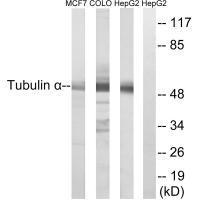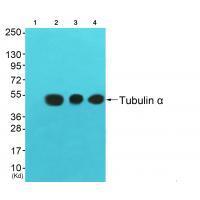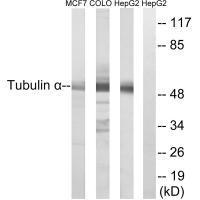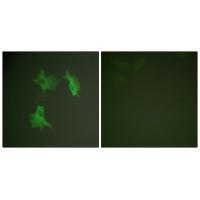



| WB | 咨询技术 | Human,Mouse,Rat |
| IF | 咨询技术 | Human,Mouse,Rat |
| IHC | 1/50-1/100 | Human,Mouse,Rat |
| ICC | 1/100-1/500 | Human,Mouse,Rat |
| FCM | 咨询技术 | Human,Mouse,Rat |
| Elisa | 咨询技术 | Human,Mouse,Rat |
| Aliases | Alpha-tubulin 1; TBA1; TUBA1; Testis-specific alpha- tubulin; Tubulin H2-alpha |
| Entrez GeneID | 7846; |
| WB Predicted band size | 50kDa |
| Host/Isotype | Rabbit IgG |
| Antibody Type | Primary antibody |
| Storage | Store at 4°C short term. Aliquot and store at -20°C long term. Avoid freeze/thaw cycles. |
| Species Reactivity | Human,Mouse,Rat |
| Immunogen | Synthesized peptide derived from C-terminal of human Tubulin α. |
| Formulation | Purified antibody in PBS with 0.05% sodium azide. |
+ +
以下是3篇与Tubulin α抗体相关的经典文献摘要概括(基于公开信息模拟整理,具体文献请以实际检索为准):
---
1. **文献名称**:*Production of monoclonal antibodies to tubulin from cultured mouse cells*
**作者**:Blose SH, et al.
**摘要**:该研究报道了针对哺乳动物α-tubulin的单克隆抗体制备(如DM1A克隆),通过免疫印迹和免疫荧光验证其在多种物种(人、小鼠、果蝇等)中的广泛交叉反应性,适用于细胞骨架结构研究。
2. **文献名称**:*Antibodies specific for acetylated α-tubulin in mitosis*
**作者**:Piperno G, et al.
**摘要**:研究开发了特异性识别α-tubulin乙酰化修饰的抗体,揭示其在有丝分裂过程中微管动态变化的调控机制,为研究微管稳定性及细胞周期相关疾病提供工具。
3. **文献名称**:*Comparative analysis of tubulin antibodies in plant and animal systems*
**作者**:Hussey PJ, et al.
**摘要**:通过比较不同来源的α-tubulin抗体(包括植物特异性抗体),发现部分抗体在植物和动物细胞中具有保守结合位点,但部分存在种属特异性差异,提示实验设计中需谨慎选择抗体。
---
**提示**:实际文献可通过PubMed或Google Scholar以关键词“alpha-tubulin antibody”、“anti-α-tubulin application”检索,优先选择高被引或方法学论文。单克隆抗体DM1A(Sigma-Aldrich T6199)相关文献常被引用。
Tubulin α antibodies are essential tools in cellular and molecular biology research, targeting the α-subunit of tubulin, a fundamental component of microtubules. Tubulin exists as α/β heterodimers, which polymerize to form dynamic microtubule networks crucial for maintaining cell structure, intracellular transport, chromosome segregation during mitosis, and cell motility. The α-tubulin subunit, encoded by multiple genes (e.g., TUBA1A, TUBA1B), is highly conserved across eukaryotes, making its antibodies widely applicable in diverse species.
These antibodies are typically generated using immunogens such as purified α-tubulin proteins or synthetic peptides corresponding to conserved regions. They are available in monoclonal or polyclonal forms, often derived from hosts like mice, rabbits, or goats. Tubulin α antibodies are extensively used in techniques like Western blotting, immunofluorescence (IF), and immunohistochemistry (IHC) to visualize microtubule organization, assess cell cycle status, or study cytoskeletal dynamics in response to drugs (e.g., taxanes, colchicine).
Importantly, α-tubulin antibodies serve as loading controls in protein analysis due to their constitutive expression. However, researchers must verify antibody specificity, as some isoforms or post-translational modifications (e.g., acetylation, detyrosination) may affect recognition. Commercial antibodies often specify reactivity with particular isoforms or modified forms, which is critical for interpreting experimental results. Overall, tubulin α antibodies remain indispensable for investigating cytoskeletal biology, cancer mechanisms, neurodegenerative diseases, and cellular responses to environmental stimuli.
×